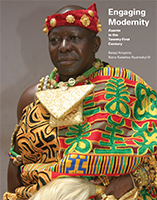
Engaging Modernity: Asante in the Twenty-First Century
Skip other details (including permanent urls, DOI, citation information): This work is licensed under a Creative Commons Attribution-NonCommercial-NoDerivatives 3.0 License. Please contact [email protected] to use this work in a way not covered by the license.
For more information, read Michigan Publishing's access and usage policy.
Kyinyɛkyimfoɔ
Nana Bogyabiyɛdɔm II, Kyinyɛkyimfoɔhene
The Akan developed a varitiy of kyinyɛ (umbrellas) in response to the need to provide a cover or canopy for their chiefs and kings. Like all objects of regalia, the various hierarchies of Akan chieftaincy have their corresponding umbrella. The Asantehene’s court has the largest collection of umbrellas. The Gold Stool has two state umbrellas, one umbrella which provides canopy for the king’s chair during processions within and outside the palace, and another special umbrella used to shield the bosomuru sword when it is taken from the palace to Akyerɛmade for the bosomuru soul washing and purification ceremony. The Asantehene’s procession requires seven different umbrellas in addition to an eighth umbrella that is used as a reserve. During processions, the reserve umbrella replaces a malfunctioning umbrella until it is hurriedly repaired and swiftly brought back to the formation. There are two types of umbrellas, bɛnkyinyɛ and krɔnpɔnkyinyɛ (also referred to as patom kyinyɛ). The former are the large ones used for ceremonies and big gatherings including Adae, Adaekɛseɛ and funerary rites. The latter are used daily in and around Manhyia Palace and when the Asantehene presides over court cases, for meetings with Asanteman or Kumaseman. The first ten photographs are Bɛnkyinyɛ followed by Krɔnpɔnkyinyɛ.
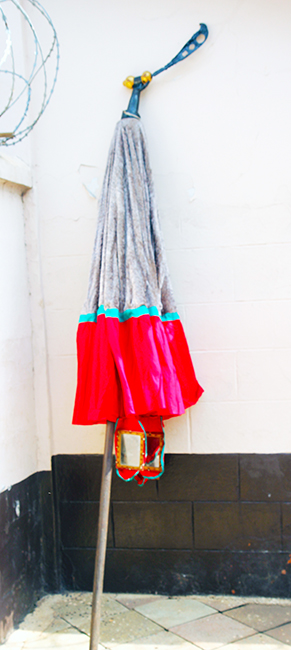
Mahwehwɛ Me Ho Asie (Nhwehwɛkyinyɛ) Akofena
This umbrella provides a canopy for the Gold Stool. It has four mirrors (nhwehwɛ) hanging from it. The ntuatire is a gilt hand, carved with wood, wrapped with gold leaf, and holding a sword (akofena). Made by Asantehene Osei Asibe Bonsu to signify his heroism in defeating several enemy states, he looked around and there were no more enemy states to attack.
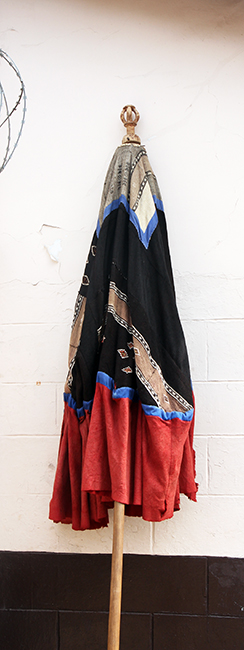
Nsaa Kyinyɛ
The umbrella that provides canopy for Asantehene’s chair during processions and recessions. It is made of the coarse blanket from northern Ghana.
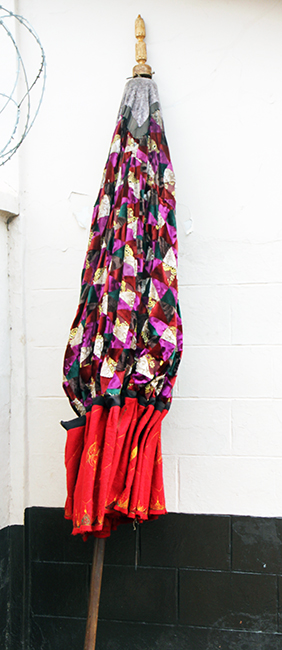
Prɛkɛsɛ
This umbrella was made for King Opoku Ware with prɛkɛsɛ as the ntuatire. The Twi word is: opie krotia a na ne ho bɔn afiem. It symbolizes the Asantehene’s omnipresence and omnipotence like that of the prɛkɛsɛ, his presence is felt everywhere.

Nanakabobonini (coiled puff-adder)
Symbol of unparalleled patience. A coiled puff-adder with ɔwam in its mouth. The puff-adder cannot fly, yet the ɔwam can fly. While hopping from tree to tree, the ɔwam fell down to the ground near the puff-adder which instantly seized it and said “me de asaase anya wam” literally, the earth has given me ɔwam.

Ebi Deda Ebi Akyi
Made by Otumfoɔ Osei Tutu II, this two-tiered umbrella denotes the superiority of the king. A reminder for the Asantehene to be always vigilant is encapsulated in the ntuatire made of the babadua, the knotted stem of a cane plant. On the other hand, babadua is able to neutralize nsuman of adversaries when they are struck with it. The text around the edge of the larger umbrella reads: Asanteman Wura, Mo ne Adwuma Pa (Asante king, congratulations for doing an excellent job).
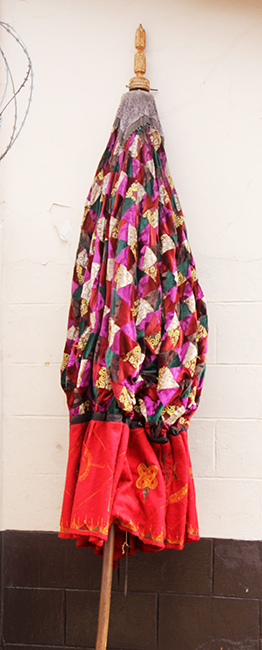
Mfoamfoa
The name describes the checkered pattern of the cloth. The mfoamfoa was made for King Osei Yaw Akoto.
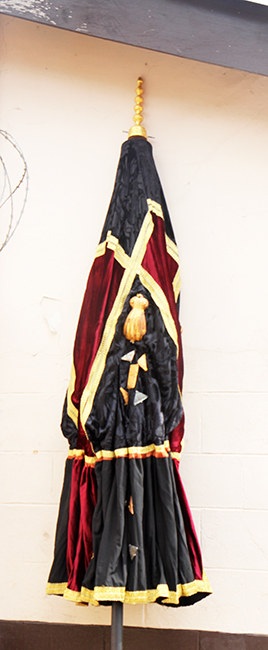
Bɔaman (destroyer of nations). Osei ne Poku Bɔaman
The elders sometimes refer to the Gold Stool as Osei ne Poku Abɛnwa. Osei Tutu’s reign was relatively shorter and he did not accomplish a great deal but Opoku Ware continued his vision and extended the Asante’s territory. Several kings were known as Osei so it may well be that Osei ne Opoku Bɔaman refers to all the kings whose names included Osei. Apurukusu (the electric fish) and nsuman are attached to it with the babadua placed on top as the ntuatire.
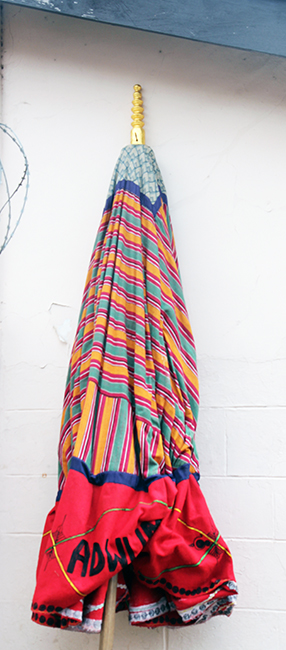
Ɔyɔkoman
Made for King Osei Tutu.The royal family belongs to the Ɔyɔko clan and as a result, this umbrella represents them. It was made for Ɔpemsoɔ Osei Tutu and it is made of silk woven kente cloth with babadua as the ntuatire. The edge is covered with nkrawoɔ (red felt cloth). The text on the edge is similar to the ebi deda ebi akyi umbrella.
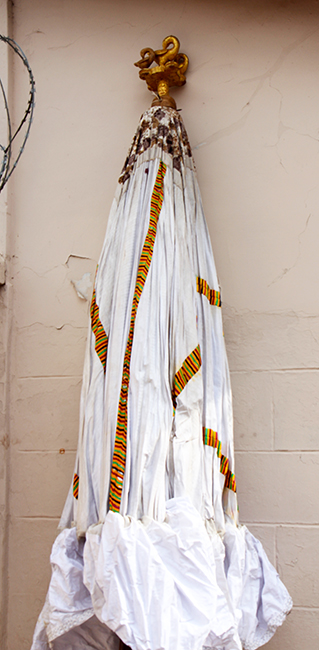
Bosomuru Kyinyɛ
Provides canopy for the bosomuru afena when it is taken from Manhyia to Akyeremade for special rites. The ntuatire is made of akokɔbaatan ne ne mma (a hen with her chicks). The hen never kills her chicks when she steps on them but she does so to correct them. White cloth accented with a strip of kente design.
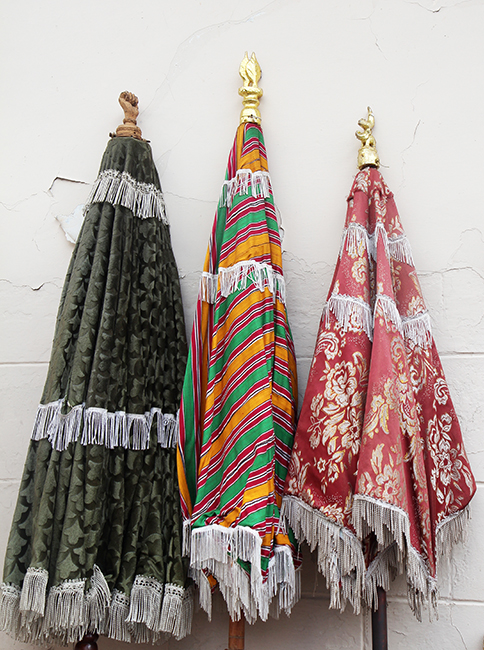
Krɔnpɔnkyinyɛ
The above umbrellas are collectively called akrɔnpɔnkyinyɛ or sometimes they are referred to as patom kyinyɛ. The umbrella on the left has a carved clenched fist as ntuatire. The meaning is that, no adversary can open the clenched fist of the king. In the middle is a krɔnpɔnkyinyɛ version of the ɔyokoman with two ahahrata leafs as ntuatire. The proverb is: Ahahrata mienu kabom a, ɛyɛ ɔpepe (when two ahahrata leaves are brought together, they yield thousands; a symbol of unity). The umbrella to the right is a gift from the Kokofuhene to Otumfoɔ. A version of Ɔyokoman with ɔsono ne akobɛn (an elephant and a war trumpet) as ntuatire. The elephant is the emblem of Kokofuhene but with the war trumpet placed on the huge elephant, he is indicating that the Asantehene is his overlord. The material and color represent Ɔyokoman since the Kokofuhene and Asantehene belong to the Ɔyoko matriclan.
Small Umbrellas: The first umbrella on the left has aborɔbɛtire as ntuatire. The proverb is: sɛ wo wura aborɔbɛfuom a, nkaseɛ ka wo honam mu. Meaning the scars from encounters with the Asantehene remain in the enemy’s body. The black umbrella in the middler has a covered yaawa (basin) as ntuatire. The third and last umbrella is a smaller version of the gift from Kokofuhene referenced above.





